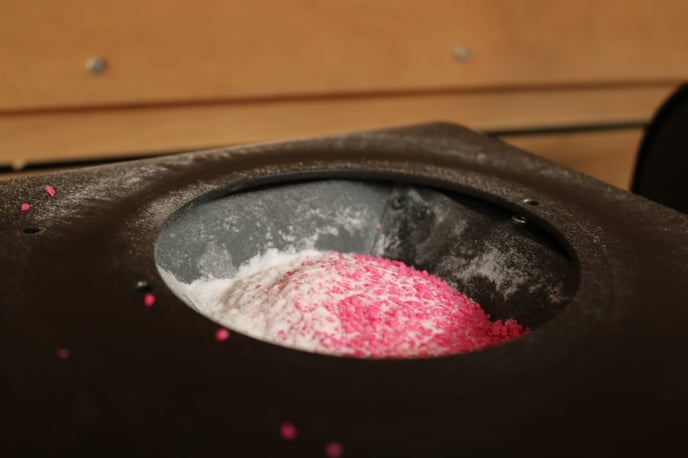Mixing additives: practical tips
Mixing inert additives homogeneously can be a challenge added to the one of making filament. In order to manage with the Filament Maker, you must be aware of several warnings and tips.
Producing filament that is stable in diameter from a virgin material is a challenge in itself.
Dispersing an additive homogeneously is an additional challenge.
Two objectives
In order to produce composite filament, you must:
- disperse the additive homogeneously in the polymer matrix
- control the stability of the flow. This applies to all extrusion experiments, even without additives. This guide covers this topic
When facing an extrusion issue in the lab, it is crucial to distinguish additive dispersion issues from flow control issues.

Warning
Increasing the proportion of additive will make it more difficult for the Filament Maker to push the material through. There will always be a threshold beyond which the plastic and screw will not be able to carry the additive. The barrel will be clogged.
The first choice
There are two ways to extrude composite filaments:
- precompound the composite pellets. Typically via twin-screw extrusion. In that case, the pellets you will feed in the Filament Maker already contain the dispersed additive, and this eliminates the first challenge written above
- feed the polymer and additive together in the hopper as separate particles
If you have that option, precompounding the material pellets will simplify the filament making step and allow you to achieve the highest filler proportions.
Additive size
This is absolutely crucial - especially if the material was not precompounded.
We achieved very successful results with additives of 100micrometers approximately.
Extremely small additives (like carbon nanotubes), and long fibers, can be very difficult to disperse.
Considering the additive size as a variable, or choosing one size around 100 micrometers, will give you the highest chance.
The plan
The following experimental plan is the safest approach to test new additives:
- find an unfilled grade and optimize the settings for it
- start with a small filler percentage (e.g. 2-5%weight)
- you might need to adjust the settings (mainly H1 and the fancooling, because additives tend to make the material more heat-transfer-sensitive)
- increase the filler percentage step-by-step
- keep an eye on the nozzle to avoid nozzle build-up
- keep an eye on the motor current in the datalog. In case of huge spikes, or values above 4-5000mA, it probably means that the filler proportion threshold has been reached. Purging the barrel is recommended.
Special tip :
Fillers tend to reduce the melt strength. As a result, the tension applied by the pulling mechanism will cause the filament to snap. Mounting a narrower nozzle (2mm for 1.75mm filament, 3mm for 2.85mm) will reduce the amount of tension needed (because the output diameter will be very close to the final product dimension).
